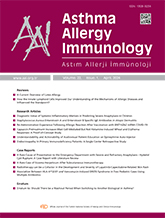


Objective: A correlation between the intensity of S. aureus colonization and skin inflammation has been demonstrated. 30-60% of S. aureus bacteria in patients with atopic dermatitis (AD) generate exotoxins, specifically superantigen-like enterotoxins A-B-C-D and toxic shock syndrome toxin-1. This study aimed to determine the role of serum staphylococcal enterotoxin A (SEA) and staphylococcal enterotoxin B (SEB)-specific IgE antibodies in children with AD.
Materials and Methods: Forty-four children with AD, 30 with allergic respiratory disease (ARD) without AD, and 25 nonatopic healthy children were included in this study. AD cases were diagnosed according to Hanifin and Rajka criteria. The severity of AD was evaluated by the `Eczema Area and Severity Index`. Serum total IgE (tIgE), SEA-specific IgE and SEB-specific IgE levels were analyzed in all children.
Results: Serum tIgE levels were significantly elevated in children with ARD without AD compared to children with AD and healthy children (p=0.041). However, there was no significant difference in the levels and the rates of positive SEA-specific IgE and SEB-specific IgE for children with AD, children with ARD without AD, and healthy children. A significantly positive correlation was detected between the EASI scores and SEA-IgE levels in children with AD (p=0.002).
Conclusion: Although the role of SEA in the pathogenesis of AD through IgE-mediated mechanisms is not fully known, the data in our study seems to provide support to the role of SEA on the severity of AD. To conclude, adding antistaphylococcal treatment to antiinflammatory therapy may be helpful in obtaining an effective clinical response in children with moderate to severe AD.